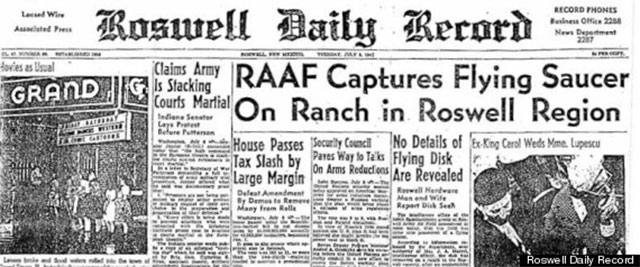
The Roswell UFO Incident
- By
- December 9, 2014
- October 14, 2021
- 29 min read
- 1
- Posted in
- UFOs, Cover-Ups
In the summer of 1947, either late June or the first week of July, a New Mexico ranch foreman named Mac Brazel reported finding strange debris in an open field near the town of Roswell. An intriguing narrative developed rapidly: The material may be from a crashed alien craft, called a “flying disk” or “flying saucer,” now known as a UFO.
The U.S. government soon claimed it was a downed high-level weather balloon and dismissed the alien crash story. Over the years, the events have become known as “The Roswell UFO Incident,” or simply “Roswell.”

The official news story from the Roswell Daily Record
In the 1970s, interest revived in the Roswell story. Did an alien spacecraft really crash in the New Mexico desert in 1947? Were aliens recovered from the crash site, possibly one or two still alive? Did the government and military work together to cover up the story? The Roswell UFO Incident has subsequently grown in the public consciousness to the point it is now widely considered the highest profile UFO case on record.
“Lydia, get ready for a scoop! We went to get this on the ABC dwire right away. Listen to this! A flying saucer has crashed… No I’m not joking. It crashed near Roswell. I’ve been there and seen it. It’s like a big crumpled dishpan. Some Ranger has halted under a cattle shelter with his tractor. The Army is there and they are going to pick it up. The whole area is now closed off. And get this – they’re saying something about little man being on board… Start getting this on the teletype right away while I’m on the phone.” [1]
-Johnny McBoyle, reporter and part owner of KSWS radio station in Roswell New Mexico on the phone to Lydia Sleppy, teletype operator at KOAT radio in Albuquerque New Mexico. July 7, 1947.
William W. “Mac” Brazel was a sheepherder and cowboy in the Southwestern United States. He loved to ride the range under the brilliant blue New Mexico sky, rustling the sheep into the barn, shearing them down and taking the wool to market for a good profit.
Mac was honorable and steadfast, a good worker, well-liked and polite. If they made a movie of his life, he might have been played by Jimmy Stewart as an “aw, shucks” cowpoke who doffed his hat and held the door open for ladies, and had plenty of candy to hand out to kids.
Mac’s wife and kids lived over in Tularosa, New Mexico, but his job as foreman of the Foster Ranch was miles away near Corona. When he was away from the family for work, he boarded at an old ranch house every evening.
Mac didn’t know it at the time, but he was about to discover what has evolved into the most famous crash in the history of UFOs.
One night in the early part of July 1947 (reports vary whether it was the 2nd or 4th of July), an enormous thunderstorm moved in, lightning crackling through the sky. Among the lighting strikes hitting the ground, he noticed one was different–it sounded more like an explosion.
The next day Mac and a neighbor boy named William D. “Dee” Proctor were checking the fences for damage or needed repairs. They came upon an area that was covered with shiny pieces and bits of something they didn’t recognize—the material covered a large area that spanned a couple of small hills separated by an arroyo. Was this scene the result of the “explosion” Mac had hear the night before?
Mac gathered up some of the debris right then, or came back with his wife and kids later to collect some of it. When they arrived back at the ranch house, he stored the material in a shed.
His daughter, Bessie, described the items in a July, 1979 interview:
“There was what appeared to be pieces of heavily waxed paper and a sort of aluminum-like foil. Some of these pieces had something like numbers and lettering on them, but there were no words that we were able to make out. Some of the metal-foil like pieces had a sort of tape stuck to them, and when these were held to the light they showed what looked like pastel flowers or designs. Even though the stuff looked like tape it could not be peeled off or removed at all. It was very light in weight but there sure was a lot of it.”
“Could it have been a weather balloon?” she was asked. “No, it was definitely not a balloon. We had seen weather balloons quite a lot, both on the ground and in the air. We had even found a couple of Japanese-style balloons that had come down in the area once. We had also picked up a couple of those thin rubber weather balloons with instrument packages. This was nothing like that. I have never seen anything resembling this sort of thing before, or since…”
In a signed affidavit she provided more detail:
“The debris looked like pieces of a large balloon which had burst. The pieces were small, the largest I remember measuring was about the same as the diameter of a basketball. Most of it was a kind of double-sided material, foil-like on one side and rubber-like on the other. Both sides were grayish silver in color, the foil more silvery than the rubber. Sticks, like kite sticks, were attached to some of the pieces with a whitish tape. The foil-rubber material could not be torn like ordinary aluminum foil can be torn.”
On either July 6or 7 of 1947, Brazel decided to visit Chaves County Sheriff George Wilcox to report the find. The sheriff contacted Major Jesse Marcel, the base intelligence officer for Roswell Army Air Field.
Major Marcel and another man went back to the ranch with Brazel on Monday, July 7. They spent that Monday afternoon trying to find any more “parts of the weather device,” according to Marcel. “We found a few more patches of tinfoil and rubber.”
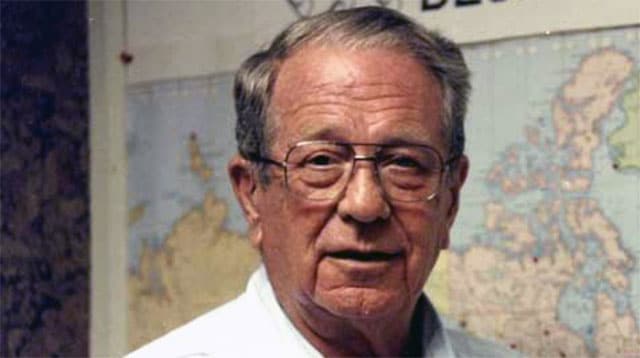
Walter Haut, the public information officer at RAAF
On July 8 Walter Haut, the public information officer at Roswell Army Air Field (RAAF), put out a press release that said individuals from the 509th Bomb Group had picked up a “flying disk” that had crashed on a ranch in the Roswell area. Several news outlets picked up on the press release right away:
“The many rumors regarding the flying disc became a reality yesterday when the intelligence office of the 509th Bomb Group of the Eighth Air Force, Roswell Army Air Field, was fortunate enough to gain possession of a disc through the cooperation of one of the local ranchers and the sheriff’s office of Chaves County. The flying object landed on a ranch near Roswell sometime last week. Not having phone facilities, the rancher stored the disc until such time as he was able to contact the sheriff’s office, who in turn notified Maj. Jesse A. Marcel of the 509th Bomb Group Intelligence Office. Action was immediately taken and the disc was picked up at the rancher’s home. It was inspected at the Roswell Army Air Field and subsequently loaned by Major Marcel to higher headquarters.
Contents
- 1 Press Interview
- 2 Faded From the News
- 3 Media Explosion
- 4 Split in the Seam
- 5 Alien Autopsy Film
- 6 U.S. Air Force Response
- 7 Difficulty with Witnesses
- 8 Lack of Credibility
- 9 Pacing the Narrative
- 10 The Roswell Myth
- 11 Roswellian Syndrome
- 12 Modern Day Developments
- 13 Hoaxes and Villains
- 14 Photos and New Developments
- 15 Excavation Attempt
- 16 Donald Schmitt’s “Witness To Roswell”
- 17 Walter in the Haut Seat
- 18 FBI Document
- 19 Area 51
- 20 Media and Publishing
- 21 A Reflection On Ourselves
Press Interview
On the night of July 8, Brazel was interviewed by a reporter from the Roswell Daily Record as well as a reporter from the Associated Press named Jason Kellahin. An AP photographer named Robin Adair took his picture and sent it out on the wire the next morning.
The Record’s interview was published the next afternoon. You’ll notice that he says the original encounter took place on June 14, but the first press release from the Army Air Field in Roswell said it was early July.
The full text is as follows:
Harassed Rancher Who Located ‘Saucer’ Sorry He Told About It
W. W. Brazel, 48, Lincoln county rancher living 30 miles south of Corona, today told his story of finding what the army at first described as a flying disk, but the publicity which attended his find caused him to add that if he ever found anything else short of a bomb, he sure wasn’t going to say anything about it.
Brazel was brought here late yesterday by W. E. Whitmore, of radio station KGFL, had his picture taken and gave an interview to the Record and Jason Kellahin, sent here from the Albuquerque bureau of the Associated Press to cover the story. The picture he posed for was sent out over AP telephoto wire sending machine specially set up in the Record office by R. D. Adair, AP wire chief sent here from Albuquerque for the sole purpose of getting out his picture and that of sheriff George Wilcox, to whom Brazel originally gave the information of his find.
Brazel related that on June 14 he and an 8-year old son, Vernon, were about 7 or 8 miles from the ranch house of the J. B. Foster ranch, which he operates, when they came upon a large area of bright wreckage made up of rubber strips, tinfoil, a rather tough paper and sticks.
At the time Brazel was in a hurry to get his round made and he did not pay much attention to it. But he did remark about what he had seen and on July 4 he, his wife, Vernon and a daughter, Betty, age 14, went back to the spot and gathered up quite a bit of the debris.
The next day he first heard about the flying disks, and he wondered if what he had found might be the remnants of one of these.
Monday he came to town to sell some wool and while here he went to see Sheriff George Wilcox and “whispered kinda confidential like” that he might have found a flying disk.
Wilcox got in touch with the Roswell Army Air Field and Maj. Jesse A. Marcel and a man in plain clothes accompanied him home, where they picked up the rest of the pieces of the “disk” and went to his home to try to reconstruct it.
According to Brazel they simply could not reconstruct it at all. They tried to make a kite out of it, but could not do that and could not find any way to put it back together so that it could fit.
Then Major Marcel brought it to Roswell and that was the last he heard of it until the story broke that he had found a flying disk.
Brazel said that he did not see it fall from the sky and did not see it before it was torn up, so he did not know the size or shape it might have been, but he thought it might have been about as large as a table top. The balloon which held it up, if that was how it worked, must have been about 12 feet long, he felt, measuring the distance by the size of the room in which he sat. The rubber was smoky gray in color and scattered over an area about 200 yards in diameter.
When the debris was gathered up the tinfoil, paper, tape, and sticks made a bundle about three feet long and 7 or 8 inches thick, while the rubber made a bundle about 18 or 20 inches long and about 8 inches thick. In all, he estimated, the entire lot would have weighed maybe five pounds.
There was no sign of any metal in the area which might have been used for an engine and no sign of any propellers of any kind, although at least one paper fin had been glued onto some of the tinfoil.
There were no words to be found anywhere on the instrument, although there were letters on some of the parts. Considerable scotch tape and some tape with flowers printed upon it had been used in the construction.
No strings or wire were to be found but there were some eyelets in the paper to indicate that some sort of attachment may have been used.
Brazel said that he had previously found two weather observation balloons on the ranch; but that what he found this time did not in any way resemble either of these.
“I am sure that what I found was not any weather observation balloon,” he said. “But if I find anything else besides a bomb they are going to have a hard time getting me to say anything about it.”
Later accounts reported this encounter took place on June 14, but the first press release from the Army Air Field in Roswell said it was early July.
The Jason Kellahin piece for the Associated Press appeared the same day in a limited number of newspapers in New Mexico and the Midwest:
New Mexico Rancher Sorry Now That He Said Anything About It
By Jason Kellahin
ROSWELL, July 9 (AP) — W. W. Brazel, the New Mexico rancher who was originally thought to have found the nation’s first “flying disc” is sorry he said anything about it.
The 48-year-old New Mexican said he was amazed at the fuss made over his discovery.
“If I find anything else short of a bomb it’s going to be hard to get me to talk,” he told the Associated Press yesterday.
Brazel’s discovery was reported Tuesday by Lt. Warren Haught [sic], Roswell Army Air Field public information officer, as definitely being one of the “flying discs” that have puzzled and worried citizens of 43 states during the past several weeks.
The statement was later discounted by Brig. General Roger Ramey, commanding general of the Eighth Air Force of which the RAAF is a component. Gen. Ramey said Brazel’s discovery was a weather radar target.
But Brazel wasn’t making any claims. He said he didn’t know what it was.
He described his find as consisting of large numbers of pieces of paper covered with a foil-like substance, and pieced together with small sticks much like a kite. Scattered with the materials over an area about 200 yards across were pieces of gray rubber. All the pieces were small.
“At first I thought it was a kite, but we couldn’t put it together like any kite I ever saw,” he said. “It wasn’t a kite.”
Brazel related this story:
While riding the range on his ranch 30 miles southeast of Corona, on June 14 he sighted some shiny objects. He picked up a piece of the stuff and took it to the ranch house seven miles away.
On July 4, he returned to the site with his wife and two of his children, Vernon, 8, and Bessie, 14. They gathered all the pieces they could find. The largest was about three feet across.
Brazel said he hadn’t heard of the “flying discs” at the time, but several days later his brother-in-law, Hollis Wilson, told him of the disc reports, and suggested it might be one.
“When I went to Roswell I told Sheriff George Wilcox about it” he continued. “I was a little bit ashamed to mention it, because I didn’t know what it was.”
“Asked the sheriff to keep it kinda quiet,” he added with a chuckle. “I thought folks would kid me about it.”
Sheriff Wilcox referred the discovery to intelligence officers at the Roswell Army Air field, and Major Jesse A. Marcel and a man in civilian clothes whom Brazel was unable to identify went to the ranch and brought the pieces of material to the air field.
“I didn’t hear any more about it until things started popping,” said Brazel. “Lord, how that story has traveled!”
Brazel said he did not see the thing before it fell, and it was badly torn up when he found it.
You can see in these stories that Brazel actually is the mild-mannered cowboy he always appeared to be. He was reluctant to share additional information about the alleged crash sites because he didn’t want to appear like he was losing his mind. In 1947 people were much less aware of UFOs than we are today.
The commanding officer of the 509th Bomb Group was William H. Blanchard. He called the Eighth Air Force in Fort Worth Texas to speak with Gen. Roger M. Ramey. Ramey immediately ordered that Blanchard should send the object to Fort Worth Army Air Field for examination. After arriving at the base, Irving Newton, the base warrant officer, agreed with General Ramey’s position that the object was a weather balloon and its “kite.” The kite is a nickname for a radar reflector that allows the weather balloon to be tracked from the ground.
General Ramey sent out a new press release which characterized the object as a “weather balloon.” Ramey had his staff take several pictures of the debris that was originally stated to come from the object. However, Jesse Marcel, who flew with the debris to Fort Worth, later said objects in the photo published by the military was not the same material he brought to them, a possible discrepancy that would further fuel the story of a government cover-up.
Faded From the News
This entire episode quickly faded from the news cycle and the people of New Mexico returned to their daily lives. It wasn’t till much later when in 1978 Stanton T. Friedman, a nuclear physicist and writer, conducted an interview with Jesse Marcel. The account that Marcel related to Mr. Friedman was the beginning of a growing interest in what has become the most well-known UFO incident in history.
Over the next 15 years several people interested in finding out more about the Roswell incident, and UFOs in general, interviewed hundreds of people that were connected, or claimed to be connected, with the Roswell events in 1947. These researchers include Friedman, Karl T. Pflock, William Moore, and the combined efforts of Donald R. Schmitt and Kevin D. Randle.
The Freedom of Information Act helped these efforts as the researchers were able to consult many documents previously unobtainable. Many authors came to the conclusion that an alien craft, or possibly even two, had crashed near Roswell. In addition, they felt that several aliens, including some that were still alive, were found and taken from the crash site. More importantly, they contended that the military and government conducted a huge cover-up of the entire series of events.
Media Explosion
The result of their efforts were many articles, publications, books, TV specials and even a TV movie that highlighted the 1947 Roswell story. Over time, the story gained steam to such an extent that by the mid-1990s many people believed that aliens were in a crash and that the U.S. Government was covering up the real story.
As new witnesses and stories emerged, and books and articles began to be published around 1980 and later, more and more people began to doubt the government’s position. The first pushback from the government was a 1994 Air Force report that went against all of the alien crash theories.
Various theories were formulated by different authors and experts, depending on which accounts were believed and which were thrown out as not credible. A common position among those that believed the government position was wrong is reflected in Randle and Schmitt’s 1991 book “UFO Crash at Roswell”:
“A UFO crashed northwest of Roswell, New Mexico, in the summer of 1947. The military acted quickly and efficiently to recover the debris after its existence was reported by a ranch hand. The debris, unlike anything these highly trained men had ever seen, was flown without delay to a least three government installations. A cover story was concocted to explain away the debris and the flurry of activity. It was explained that a weather balloon, one with a new radiosonde target device, had been found and temporarily confused the personnel of the 509th Bomb Group. Government officials took reporters’ notes from their desks and warned a radio reporter not to play a recorded interview with the ranch hand. The men who took part in the recovery were told never to talk about the incident. And with a whimper, not a bang, the Roswell event faded quickly from public view and press scrutiny.” [2]
“The Roswell Incident”
However, 11 years before “UFO Crash at Roswell” was released, one of the first major books regarding the Roswell events was “The Roswell Incident,” released in 1980 by Charles Berlitz and William L. Moore. Although not mentioned in the credits, Stanton Friedman was also a major contributor.
The book has extensive interviews with over 90 witnesses. Jesse Marcel was quoted as describing the debris found at the crash site as “nothing made of this earth.” Other witnesses described the material as being super strong and having qualities they had never seen in any other terrestrial material, certainly not of any weather balloon or similar weather instrument.
“The Roswell Incident” also posited that the original photographs showing Marcel with the debris was swapped out for a traditional weather device by General Ramey and others in the military. The original debris was never provided to impartial observers to examine. The book also went into detail about cover-up activity by the military–such as attempts to discredit the original observations of Mac Brazel through intimidation and incarceration.
Other significant accounts included that of Barney Barnett. Although he had passed away years before, friends related that he had many times described a flying saucer crash and alien bodies about 150 miles west of the Foster ranch.
According to Barnett, he was with a group of archaeologists when they came upon the crash site of an alien flying disk and unfortunate crash victims on July 3, 1947. They were quickly taken from the area by military personnel. Barnett’s story raised the possibility of a second crash, or possibly the debris from the Barnett crash ended up being spread over the arroyo at the Foster ranch.
Randle and Schmitt – “UFO Crash at Roswell”
While “The Roswell Incident” cracked the door a bit, “UFO Crash at Roswell,” by Kevin D. Randle and Donald R. Schmitt, kicked it open. Released in 1991, it capitalized on the growing publicity and public awareness of the Roswell events and the revelations of several eyewitness accounts.
Some of the original timelines were clarified. For example, the original date that Mac Brazel reported the existence of the site which led to Marcel coming out to the ranch was Sunday, July 6, not the day after as originally claimed.
Further, new information, such as stories about a “gouge… that extended 400 or 500 feet” at the Foster ranch, and an extensive recovery operation, was divulged. The book also discussed the Barnett accounts, although they altered the dates and locations from “The Roswell Incident.” This time, they said that Brazel led the Army to a second crash and that the Army was “horrified to find civilians there already.”
The authors also outline the sequence of events that tracks the alien corpses from the crash site–shipped to the airfield at Roswell, on to Fort Worth, and eventually to Dayton Ohio’s Wright Field.
Friedman’s “Crash at Corona”
Stanton Friedman again took center stage on the UFO scene when he published “Crash at Corona” with Don Berliner in 1992. Friedman used the knowledge he gained writing “The Roswell Incident” to help them build a case of a cover up of a recovered UFO. They based their position on evidence they discovered including documents in the Majestic 12 archive.
Also known as MJ-12, the Majestic 12 was the alleged code name for a secret cabal of government, scientific, and military leaders. It was created by executive order by President Harry Truman. Their sole reason for being was to investigate the Roswell incident.
The existence of the Majestic 12 first came to light in 1978 in several declassified documents in Canada. Contributing to the confusion of researchers attempting to get to the truth of the whole Roswell crash story was a series of fake documents that surfaced in 1984 in the U.S. They also referred to the Majestic 12 and, while they were very good recreations of actual documents, the Federal Bureau of Investigation found them to be completely false.
The sequence of events in “Crash at Corona” is similar except this time they have Brazel being quarantined by the military for up to a week before he talked to the Roswell newspaper with his “revised story” that was fed to him by the government.
“Crash at Corona” also puts the Barnett account closer to Socorro and adds a new account from Gerald Anderson who described the crashed flying saucer with four alien passengers, one of whom lived. The book agrees with much of the narrative from “UFO Crash at Roswell,” specifically that the aliens were spotted by eyewitnesses at the Roswell Army Air Field before being sent to Fort Worth and on to Dayton.
Randle and Schmitt Part 2 – “The Truth About the UFO Crash at Roswell”
Another cornerstone book about the Roswell incident is the 1994 book “The Truth about the UFO Crash at Roswell,” also published by Randle and Schmitt. It is an expanded and updated version of their 1991 publication. It included more details about the aliens and where the recovery took place. The authors also presented a revised version of the timeline of events. [3]
For example, they now said that the alien object crashed on the night of July 4 rather than July 2. Here is a major change in the narrative: they say the government was already recovering the aliens when Mac Brazel made his first discovery of the debris at the ranch.
In this scenario, the government had tracked the alien craft on radar. The Brazel story was part of the plan to deflect attention from the “true” location where the alien craft crashed.
The authors also related a new story about an alien craft and its crew from Jim Ragsdale, apparently crashing at a location north of Roswell, a story backed up by several archeologists working in the area. In this account, five alien corpses were discovered.
Another important development is the chapter that dismisses Barnett’s and Anderson’s accounts from “Crash at Corona” and “The Roswell Incident.” They also include an appendix that details the Majestic 12 documentation as a hoax.
Both Randle and Schmitt publications are widely quoted by UFOlogists. The authors said they have interviewed 500 people during their investigation into the Roswell incident.
Split in the Seam
Interestingly, the release of “The Truth About The UFO Crash at Roswell” marked a separation among UFO experts and followers as to the sequence of events at Roswell and the actual locations of crashes. The Mutual UFO Network (MUFON) and The Center for UFO Studies (CUFOS) are the leading UFO communities.
They differ on the explanations presented by Friedman and Berliner as opposed to Randle and Schmitt. They have tried to get agreement among the various members, but “The Truth About the UFO Crash at Roswell” blew those attempts apart when it ignored the Barnett “problem” and indicated a completely new site where the alien recovery was to have taken place.
Alien Autopsy Film
1n 1995, UFO communities and the world at large were stunned by the release of film footage that showed an alien autopsy performed by the US military after the Roswell recovery. The footage showed doctors cutting open and removing “organs” from aliens lying in an operating room.
A London filmmaker named Ray Santilli, who released the footage, later admitted that it was only a recreation. He still claims it was based on real footage from a secret source, and that the original film was now lost.
U.S. Air Force Response
During the 1990s, the U.S. Air Force published a pair of reports designed to answer the question of the debris as well as recoveries of alien bodies. They explained that the debris was simply from a high-altitude balloon that was part of Project Mogul, a top secret experiment designed to detect Soviet ballistic and nuclear activity.
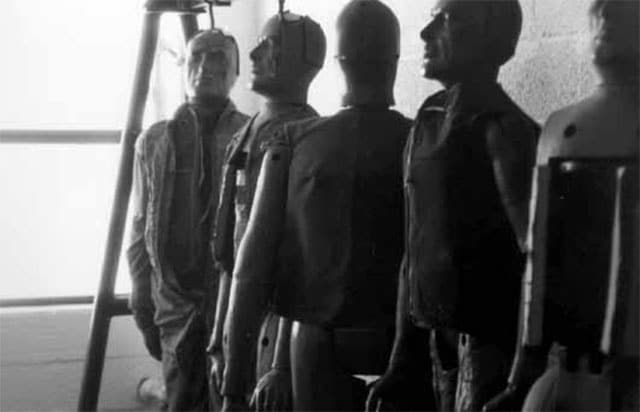
Test dummies
In addition, they explained away the stories of alien recoveries by saying they were a combination of military projects using dummies in place of live personnel, real accidents involving military members, and hoaxes.
The reports were the first official counter to the growing alien recovery narrative that expanded in the late 1970s. However, independent skeptics like Robert Todd and Philip J. Klass had long published their doubts about UFOs before the appearance of the Air Force publications.
Difficulty with Witnesses
While hundreds of different people related to the Roswell incident have been interviewed by various researchers over the years, only a few actually were at the sites, and fewer handled the debris. For example, in his book “Roswell: Inconvenient Facts and the Will To Believe,” Karl T. Pflock points out that around 300 people were interviewed by Randle and Schmitt for “UFO Crash at Roswell.”
Of that number, only 41 were primary or secondary “witnesses to the events in and around Roswell or at the Fort Worth Army Air Field,” and 23 were believed to be “reasonably thought to have seen physical evidence, debris recovered from the Foster Ranch.” According to Pflock, an even smaller number–only seven–have posited that the debris had anything to do with aliens.
Lack of Credibility
Possibly the biggest difficulty has been verifying the credibility of sources that claimed to actually see aliens. Either the accounts were second-hand, or the claimants made many different statements, sometimes contradicting themselves. Also, some interviewees were elderly, easily confused or found it difficult to remember what happened. In fact, the time delay between 1947 and the 1970s and 1980s affected all interviewees. It is a long time to try to remember exact details of the events.
Perhaps one of the most damaging developments were the flip-flopping accounts of Jesse Marcel himself. First, he said what was recovered was “not of this world.” Statements like that are what created much of the initial interest at Roswell. Later, Timothy Printy indicated that the material Marcel had previously said was definitely part of the first debris they recovered was identified by experts and UFOlogists alike as being part of a weather type balloon.
When Marcel was told of this, he changed his story, saying that the material was not part of the group of objects they recovered. Roger G. Todd, a UFO skeptic, pointed out that Marcel had often exaggerated and changed his story. For example, at one point Marcel said he was a decorated war pilot with many kills. That later proved to be false, also casting doubt about his veracity regarding the Roswell incident.
Pacing the Narrative
There is another aspect with the Roswell incident related to the long time between the original events and the interviews that tried to reconstruct them. Because the Roswell incident is so famous, it tends to mold people’s memories and answers.
A similar thing happened in the northern part of the state when some experts speculated that the supernova petroglyph at Chaco Canyon might be an actual record of a supernova. However, originally it was believed to be a site for the local Zunis to watch the sun. Interestingly, the Zunis began to use the supernova record narrative when giving answers in interviews. They started to shape their answers to fit the questions of the interviewers. This same phenomenon might have influenced the interviews surrounding Roswell.
The Roswell Myth
Another aspect of the Roswell case is that many alien crash stories have become intertwined in the single event. Karl Pflock, who was previously a supporter of the Roswell incident and later became a skeptic, said, “[T]he case for Roswell is a classic example of the triumph of quantity over quality. The advocates of the crashed-saucer tale… simply shovel everything that seems to support their view into the box marked ‘Evidence’ and say, ‘See? Look at all this stuff. We must be right.’ [emphasis in original] Never mind the contradictions. Never mind the lack of independent supporting fact. Never mind the blatant absurdities.”
Others like Karl Korff say many people have incentive to support the idea of aliens in the area, while still others are providing shoddy research efforts: “Let’s not pull any punches here: The Roswell UFO myth has been very good business for UFO groups, publishers, for Hollywood, the town of Roswell, the media, and UFOlogy … [The] number of researchers who employ science and its disciplined methodology is appallingly small.”
Some like Charles Ziegler believe that the Roswell narrative is very similar to the structure of traditional stories handed down though the generations. In essence, the Roswell case has become a modern day folk story.
Roswellian Syndrome
In fact, Joe Nickell and James McGaha, both skeptics, wrote a piece for Skeptical Inquirer that broke down the development of the Roswell case as an entire mythmaking machine they call the “Roswellian Syndrome.”
There are five stages to the myth development process:
- Incident – the original events.
- Debunking – calling the UFO story a hoax and relabeling the object as a weather balloon.
- Submergence – the weather balloon meme quieted the waters.
- Mythologizing – After submergence, the story lingered and grew.
- Reemergence and Media Bandwagon Effect – by the 70s and 80s, they story reemerged with books, TV shows, and other media. The myth has now grown to epic levels.
Nickell and McGaha wrote that these developments are tied to Roswell but also can be seen in other UFO cases. They predict the process will be replayed in future UFO incidents as well as other conspiracy-type situations.
Modern Day Developments
One of the interesting reactions to the Air Force reports came from some prominent UFO researchers. They decided that the Roswell case did not involve any alien aircraft or passengers at all. They base their decision partly on the Air Force report, and partly on the knowledge that the Air Force didn’t even know what the “flying disks” being reported were, believing they may have been Soviet spying machines.
Karl T. Pflock explained this view in the Klass Files in January 1997, saying,
“Based on my research and that of others, I’m as certain as it’s possible to be without absolute proof that no flying saucer or saucers crashed in the general vicinity of Roswell or on the Plains of San Agustin in 1947. The debris found by Mac Brazel…was the remains of something very earthly, all but certainly something from the Top Secret Project Mogul….The formerly highly classified record of correspondence and discussions among top Air Force officials who were responsible for cracking the flying saucer mystery from the mid-1940s through the early 1950s makes it crystal clear that they didn’t have any crashed saucer wreckage or bodies of saucer crews, but they were desperate to have such evidence …”
Another early believer in the Roswell incident, William T. Moore, author of “The Roswell Incident,” later supported the Pflock position, saying, “After deep and careful consideration of recent developments concerning Roswell…I am no longer of the opinion that the extraterrestrial explanation is the best explanation for this event.”
Hoaxes and Villains
One of the problems dogging the Roswell incident have been experts who later proved to be less than credible. For example, while Stanton Friedman, Kevin Randle and Donald Schmitt were all considered experts on the Roswell incident, one of the Air Force reports said that even basic research that was purported to have been performed was in fact not conducted.
Also, Schmitt said he had several college degrees and was pursuing a doctorate. He also said that he was an illustrator in the medical field. When others researched the veracity of the statements, it turned out he was in fact a mailman in a small town in Wisconsin with no bachelors or advanced degrees. Randle later said Schmitt, “…will lie about anything. He will lie to anyone… He has revealed himself as a pathological liar… I will have nothing more to do with him.”
If that wasn’t enough, it was shown later that several important witnesses were fabricating stories, or at least suspected of it. Frank Kaufmann was one of the more prominent witnesses in “The Truth about the UFO Crash at Roswell” and was later found to have forged several documents and fabricated his real role at the Roswell incident. The authors of the book later recanted his stories in two articles published in 2002.
One witness featured prominently in “UFO crash at Roswell,” Glenn Dennis, originally said that alien autopsies were performed at the base in Roswell. Later, Randle considered Dennis to be a poor witness, calling him not credible because he changed details once he was challenged. Karl T Pflock also questioned Dennis’ accounts.
Photos and New Developments
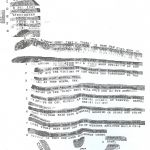
David Rudiak on General Ramey’s Memo
Another interesting development was the claim by UFO researcher David Rudiak, and others, who said that a telegram that can be seen in one of the photos of the balloon debris. They say that the text of the telegram confirms the theory that an actual “disk” and aliens were part of the recovery. An enlargement of the photo, Rudiak claimed, shows phrases such as “the victims of the rack” and “in/on the disc” as well as additional phraseology that indicates the recovery of a crashed disc.
These theories have been debunked with closer examination. One researcher, James Houran, Ph.D., indicated that the phrases, words and letters are difficult to read even upon enlargement. Other experts don’t believe a General would let himself be in a photograph holding a telegram such as the one indicated.
Excavation Attempt
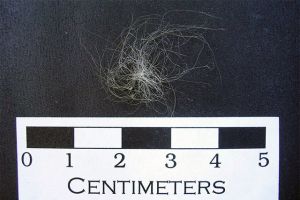
Unknown white fibers found during the 2002 excavation
In 2002, the Sci-Fi Channel had a fascinating idea. They sponsored a full excavation at the original site Mac Brazel discovered the debris. They hoped to find any objects left behind by the military or possibly buried in the soil on impact. Unfortunately, they didn’t find anything to prove their theory.
At the time, the project attracted the attention of the governor of New Mexico, Bill Richardson, who also was the head of the United States Department of Energy. In 2004, he penned a forward to “The Roswell Dig Diaries,” saying, “the mystery surrounding this crash has never been adequately explained – not by independent investigators and not by the U.S. Government.”
A few years later, Richardson expanded his comments. He stated that when he was a congressman, he tried to get more information about the Roswell crash for his constituents in the state. He was rebuffed by both the Department of Defense and Los Alamos labs, telling him that the information was classified. “That ticked me off,” he said at the time. “The government doesn’t tell the truth as much as it should on a lot of issues.”
In 2005, the American Broadcasting Company television network also aired a UFO special hosted by their national news anchor Peter Jennings. ABC supported the Air Force report about the Roswell incident. Jennings blasted the Roswell events as “myth… without a shred of evidence.”
Still, some of the original researchers are steadfast in their belief. Stanton T Friedman continues to support his position about the Majestic 12 documents that give details about the secret cabal of government, military and scientific leaders hiding all of the data on recovered discs and alien bodies.
In an updated version of his 1996 book “Top Secret/Magic,” Friedman wrote, “I am still convinced Roswell really happened, and that the Eisenhower briefing document… and others are the most important classified documents ever leaked to the public.”
Donald Schmitt’s “Witness To Roswell”
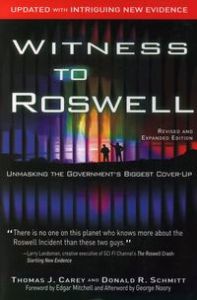 Donald Schmitt and his partner Tom Carey published “Witness to Roswell” in 2007. Here they focus on the initial claim of a flying saucer being recovered. They state they had a “continuously growing roster of more than 600 people directly or indirectly associated with the events and Roswell who support the first account – that initial claim of the flying saucer recovery.” They also describe brand-new accounts of both aliens and alien recoveries, one of which came from Walter Haut, the man who penned the original press release during the original series of events. [4]
Donald Schmitt and his partner Tom Carey published “Witness to Roswell” in 2007. Here they focus on the initial claim of a flying saucer being recovered. They state they had a “continuously growing roster of more than 600 people directly or indirectly associated with the events and Roswell who support the first account – that initial claim of the flying saucer recovery.” They also describe brand-new accounts of both aliens and alien recoveries, one of which came from Walter Haut, the man who penned the original press release during the original series of events. [4]
They also put forward the theory of a crash taking place on the evening of Thursday, July 3, 1947. They also suggest that Brazel brought debris to Corona, and displayed it to several residents in a local tavern, retail store and other locations. In addition, he took some down to Capitan and some objects ended up at a local rodeo on July 4.
Several people say they saw the debris field and took many objects before Brazel reported the find on July 6. After the military found out about the debris, they tried to recover the souvenirs Brazel handed out to people. “Ranch houses were and [sic] ransacked. The wooden floors of livestock sheds were pried loose plank by plank, and underground cold storage food sellers were emptied of all their contents.”
Other events are reported to be similar to other books. However, one significant difference is the theory of the recovery of a second alien crash at the Foster place. This is the same site mentioned in the 1991 book, “UFO Crash at Roswell.” Schmidt and Carey wrote that Brazel found this second site several days after discovering the field of debris, and finding the second site is what propelled him to report his find to the authorities in Roswell.
In addition, they claim that major Marcel viewed bodies of aliens. This claim was not made in any of the previous books listed above. Two different witnesses, a relative and a military technical officer who were part of Marcel’s intelligence team, state that Marcel was able to briefly saw alien bodies.
Significant parts of the book are devoted to additional new accounts from several witnesses to support the view that alien bodies were discovered both at the Foster ranch and at another site along with an alien craft, with the bodies and craft examined in a hangar and hospital at the base, flown out in containers.
The book presents additional information on the man who drafted the original press release that was submitted to press outlets on July 8, 1947, which announced a “flying disk,” Walter Haut. He apparently signed an affidavit in 2002 where he admits to significantly more knowledge and involvement in the Roswell events. He said that he saw corpses of aliens and the aircraft itself, as well as evidence of a cover-up. Haut passed away in 2005.
Another fascinating first-hand account in the book came from Elias Benjamin, an MP at the base. He says he was tasked with guarding aliens moving from the Roswell hospital from a hangar. Also, relatives of the secretary to the chief medical officer on the base, Miriam Bush, related stories she told of being led into a hospital examination room with alien bodies laid out on gurneys. Both of these stories claimed that one of the aliens was still living.
Another incident from the book describes how New Mexico Lt. Gov. Joseph Montoya was at the base at the time. A local family named the Anayas picked him up at the base when a flustered Montoya related a wild story of seeing four alien bodies at the base hangar, with one of them still living.
Walter in the Haut Seat
As mentioned earlier, Walter Haut signed an affidavit that was published in “Witness to Roswell,” where he outlined the story of a cover-up and his personal observation of alien corpses. The story created significant buzz in the UFO community. Some were happy he provided the information as it confirmed their belief about the presence of aliens at the Roswell incident. Skeptics questioned the veracity of his statements.
One skeptic was UFO researcher Dennis G. Balthaser, who along with Wendy Connors interviewed Haut in a 2002 on-camera conversation. He felt that the man in the interview could not possibly be the one who created the document that he signed: “The 2000 video shows a man that couldn’t remember where he took basic training, names, dates, etc., while the 2002 affidavit is very detailed and precise with information that Haut can accurately remember two years after he was videotaped.”
This view gained support when “Witness to Roswell” co-author Schmitt said that the original affidavit was in fact not panned by Haut, rather was created for him to simply sign. Schmitt said it was created from statements that Haut had made to Schmidt and his co-author Tom Carey over several years. Balthaser said that the entire signing was in doubt because neither Schmidt nor Kerry were present when the affidavit was signed. Further, the witnesses that were present had never been revealed.
Nonetheless, in both the affidavit and the video interview Haut says he saw an alien craft, and at a minimum one body in a hanger on the base. He also says that he was present at a staff meeting where General Ramey began to initiate a cover-up.
Haut’s own daughter, Julie Shuster, Director of the International UFO Museum in Roswell, simply said that Schmitt had created the affidavit based on several conversations over a long period of time that both Schmitt and Carey had with her father. In an article for the MUFON newsletter published in September of 2007, she said she reviewed the affidavit with her father and that “he did not want to make any changes.” As result, he signed the affidavit, and it was witnessed by two individuals, the visitor and a notary public.
FBI Document
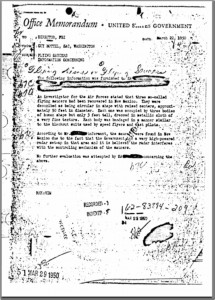
The 1950 FBI document (Guy Hottel)
In 1950, an FBI agent named Guy Hottel wrote a memo about a report from an Air Force investigator. The report described three separate alien craft recovered in New Mexico along with their passengers. He wrote that “three so-called flying saucers” were found. They were described as being circular with a raised area in the center, with a diameter of approximately 50 feet.
Inside each craft, there were three occupants of “human shape,” approximately 3 feet tall and dressed in “metallic cloth of a very fine texture.” There was speculation that “high-powered radar” had caused the alien craft to crash by inadvertently scrambling their navigational systems and controls.
Although no dates are mentioned, the memo itself is dated March 22, 1950, with the most detailed location specified as “New Mexico.” He wrote that “no further evaluation was attempted by the Air Force investigator who presented the data.”
This document was posted by the FBI on their website in April of 2011. Several sources have found connections between it and the Roswell incident. However, many sources have shown that this document was revealed to be a fake many years ago, including an article in True magazine published in 1952. The hoax was a scheme by two men, Leo A. Gebauer and Silas Newton. They were hawking a phony machine that was supposed to be able to find gas, oil, gold or other precious items with alien technology. In 1953, the duo was found guilty of fraud.
Area 51
Area 51 is a military base in the southern region of the state of Nevada in the Western portion of the United States. It lies approximately 83 miles from Las Vegas. While the activities there are top-secret, is widely accepted that the base exists to test experimental weapons and aircraft. While the Central Intelligence Agency does use the name Area 51 in an official capacity, other names used for the base include Paradise Ranch, Watertown Strip, Groom Lake, Dreamland, Home Base and Homey Airport. The airspace around Area 51, known by military pilots as “the box” or “the container,” is restricted.
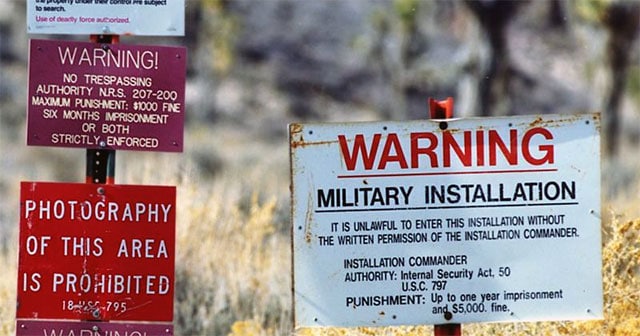
Area 51 warning signs
Annie Jacobsen published the book “Area 51: An Uncensored History of America’s Top Secret Military Base,” in which she conducted interviews with many engineers and scientists who worked on the base. She denies any alien narrative regarding Roswell.
She puts forth a suggestion that Josef Mengele was asked by Joseph Stalin, the Soviet leader, to create “grotesque, child size aviators” to be flown and land in the United States to create hysteria. The goal was to duplicate a mass reaction similar to the chaos from Orson Welles radio play “War of the Worlds” in 1938. She believes that instead of landing as planned, an aircraft crashed at Roswell and the incident was kept quiet by military and government officials in the United States. However, her book and theories were debunked by a couple of experts at the Federation of American Scientists for multiple errors.
Media and Publishing
The 1947 Roswell events have inspired a number of movies, video games, TV programs and publications. Movies related to the incident include:
- The book “UFO Crash at Roswell” was used for inspiration for the movie “Roswell,” starring Martin Sheen and Kyle MacLachlan.
- “Independence Day” centered on Area 51, recovered alien craft and alien bodies.
- “Indiana Jones and the Kingdom of the Crystal Skull” includes Indiana Jones taking Soviet operatives to a mummified alien body from Roswell.
Several works of fiction have included references to the Roswell phenomena including:
- “Majestic” by Whitley Strieber.
- “Operation Roswell” by Kevin D Randle.
- “Stargate SG One: Roswell” by Sonny Whitelaw.
- “The True Meaning of Smekday” by Adam Rex.
- “Gotcha Gas: Debacle Near Roswell” a parody by Banak and Weimer.
Nonfiction works include:
- “The Truth about the UFO Crash at Roswell” by Kevin D Randle and Donald R Schmitt.
- “The Roswell Legacy” by Jesse Marcel, Jr. And Linda Marcel.
- “Alien Interview” edited by Lawrence Spencer
- “The Day After Roswell” by Col. P.J. Corso.
TV series include:
- “Roswell,” which aired from 1999 to 2002 on the WB television network and UPN.
- A “Futurama” episode named “Roswell That Ends Well.”
- A “Star Trek: Deep Space Nine” episode named “Little Green Men.”
- “Dark Skies” an NBC television series that aired 1996-97.
- “Seven Days,” a 1998- 2001 UPN series.
Comics, cartoons and animation influenced by Roswell include:
- “The Invisibles” by Grant Morrison.
- A “Bongo Comics” series named “Roswell, Little Green Man,” released from 1996 to 1999.
- “Roswell, Texas”, a graphic novel.
- The comic “Hetalia: Axis Powers.”
- “Atarian Conquest,” a comic from America.
In the world of music, several works were inspired by Roswell including:
- “The Crash of ’47,” by hard rockers Atomship.
- The hard rock band “Foo Fighters” is named after a term for UFOs.
- The song “Mac Brazel’s Farm” by singer/songwriter John Stewart.
- “Roswell 47” by death metal band Hypocrisy, based in Sweden.
A Reflection On Ourselves
No matter what the government says, the Roswell story is too big to ignore. Are we that conceited that we think we are the only people in the cosmos? There are millions of star systems “out there.” It is folly to believe we are alone.
More importantly, the Roswell incident tells us more about ourselves than anything else. In 1995, Phil Cousineau wrote in “UFOs: A Manual for the Millennium”: “Something happened at Roswell that has come to symbolize what we don’t yet know about the nature of life on other planets, the possibility of inter-galactic travel, the state of national security, and how far the government will go to ensure it.”
References
| ↑1 | The Roswell Incident – The Classic Study of UFO Contact, Charles Berlitz and William Moore, ISBN 9780586 051825 |
|---|---|
| ↑2 | UFO Crash at Roswell, Kevin D Randle and Donald R Schmitt, ISBN 9780380 761968 |
| ↑3 | Truth about UFO Crash Roswell, Kevin D Randle and Donald R Schmitt, ISBN 9780871 317612 |
| ↑4 | Witness to Roswell, Unmasking the Governmet’s Biggest Cover-Up, Thomas Carey, Donald Schmitt, and Edgar Mitchell, ISBN 9781367 480038 |
Fact Checking/Disclaimer
The stories, accounts, and discussions in this article may go against currently accepted science and common beliefs. The details included in the article are based on the reports, accounts and documentation available as provided by witnesses and publications - sources/references are published above.
We do not aim to prove nor disprove any of the theories, cases, or reports. You should read this article with an open mind and come to a conclusion yourself. Our motto always is, "you make up your own mind". Read more about how we fact-check content here.
Copyright & Republishing Policy
The entire article and the contents within are published by, wholly-owned and copyright of UFO Insight. The author does not own the rights to this content.
You may republish short quotes from this article with a reference back to the original UFO Insight article here as the source. You may not republish the article in its entirety.
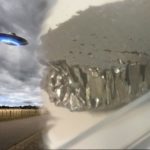
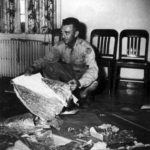
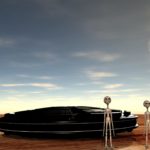
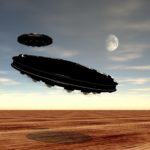
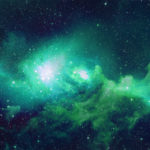
1 Comment
UFO Insight does not take responsibility for the content of the comments below. We take care of filtering profanity as much as we can. The opinions and discussion in the comments below are not the views of UFO Insight, they are the views of the individual posting the comment.
Newest comments appear first, oldest at the bottom. Post a new comment!
Editor:
Fifty years ago, I was a Radio Intercept Analyst in the USAF Security Service. a ‘Sherlock’ with full access to Top Secret DINAR–A worldwide surveillance network.
My specialty was the Soviet Union.
In the Cold War of electronic intelligence-gathering, US surveillance missions got ‘cover stories’ –‘weather reconnaissance’, ‘navigational training’ or ‘mapping reconnaissance’.
Over the years, fifty Americans were killed, shot down by Russian MiGs.
Their loved ones got ‘cover stories.’
Radar tests had begun in 1947 for the grandest, most spectacular ‘black op’ ever conceived.
When an unforeseen ‘incident’ threatened to compromise the operation, America and the world got a ‘cover story’.
At the height of the Cold War, the most successful intelligence-gathering mission in history exposed the Soviet air defense system and history never found out.
Why not?
That 1947 ‘cover story’ had taken on a life of its own. And it’s still flying high.
Top Secret DINAR
How Roswell Saved America
The nation has to know.
Kevin Ahearn AF12692687 6901st SCG